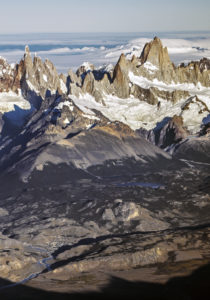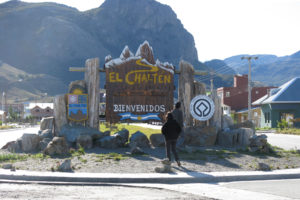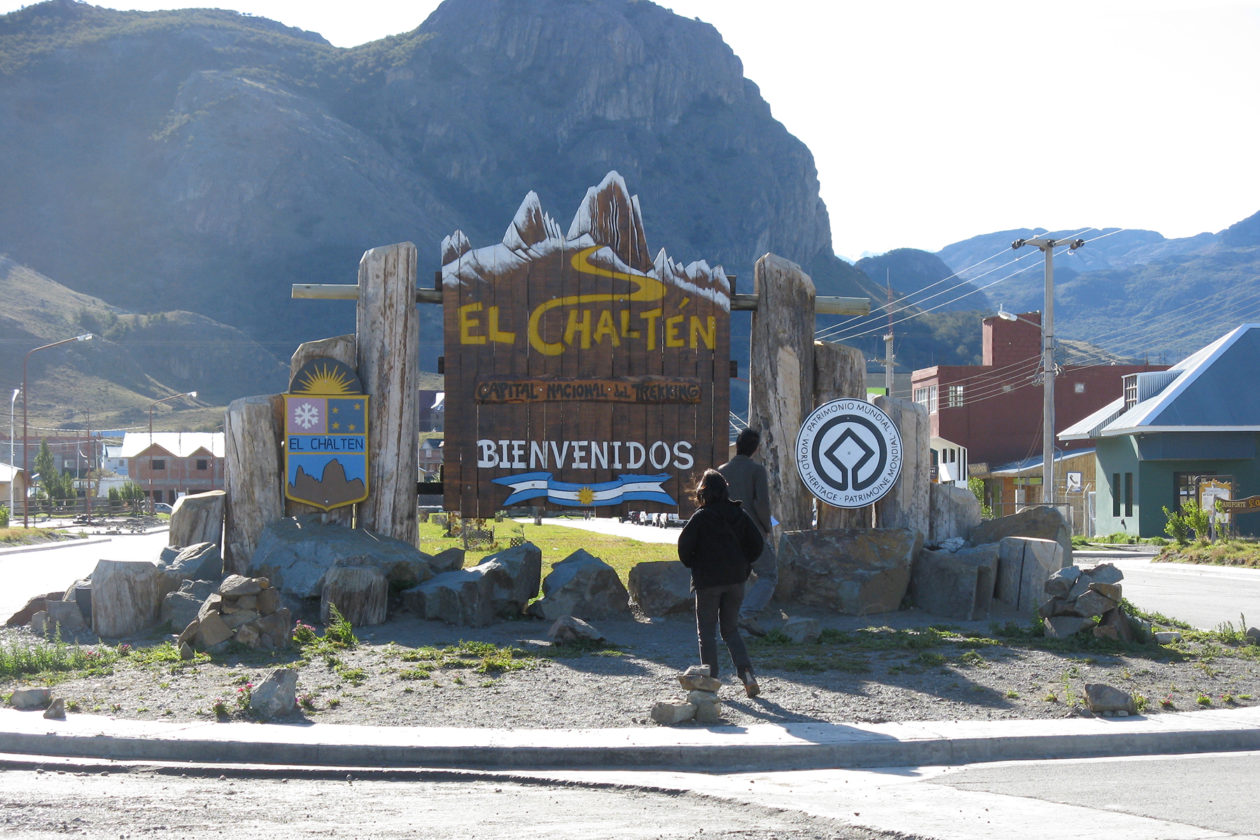The Patagonian Sublime: The Green Economy and Post-Neoliberal Politics
By: Marcos Mendoza (University of Mississippi)
What is the significance of the green economy (and ecotourism) to New Left politics in Argentina? I seek to answer this question in my recently published ethnography, The Patagonian Sublime, which is based on eighteen months of fieldwork conducted primarily in the Argentine mountain village of El Chaltén and the adjacent Glaciers National Park (see Image 1). The New Left refers to the wave of center-left and leftist governments that have come power in Latin America over the last two decades, rejecting armed revolution in favor of electoral democracy. Responding to the crises, conflicts, and contradictions associated with neoliberalism, the New Left has articulated a wide range of policy responses that have sought to promote more equitable growth and to rebuild the social state. These governments – using more and less strident language – have attacked key assumptions of neoliberal capitalism while seeking to implement new visions for citizenship, development, sovereignty, and international engagement. Though facing a number of recent electoral setbacks, the New Left remains a vibrant source of post-neoliberal political imagination, seeking to build a counterhegemonic front from within the global neoliberal order. In Argentina, the Néstor Kirchner (2003-2007) and Cristina Fernández de Kirchner (2007-2015) presidential administrations are associated with post-neoliberal politics. Latin America’s most powerful political couple in the early twenty-first century, Kirchner and Fernández have pursued a “neo-developmentalist” economic approach focused on promoting natural resource exploitation and delivering material improvements to the lower, working, and lower-middle class constituents that comprise their base of electoral support.

Green Productivism
The green economy is a central pillar of the resource exploitation strategy promoted by Kirchner (who passed away in 2010) and Fernández. In particular, The Patagonian Sublime argues that the Kirchner-Fernández administrations implemented a “green productivist agenda” based on a particular mode of capitalist development, political rule, and national representation. First, the green productivist agenda involves a commitment to rentier capitalism based on ecotourism-led growth within national parks. Protected areas offer the tourism industry and the conservation state (i.e. national park administration) the opportunity to create territorial monopolies over access to key tourism destinations. The tourism industry and conservation state also work to create place brands for different parks organized synergistically across regional landscapes, thereby generating symbolic monopolies operating in tandem with territorial monopolies. Second, the Argentine conservation state has utilized “community-based conservation” as a strategy of political rule. Seeking to move beyond past associations with authoritarian control over parks, the conservation state has developed a more decentralized, democratic form of land management that attempts to incorporate citizen perspectives into sustainable development plans. In doing so, however, community-based conservation grants legitimacy to ecotourism frameworks that reproduce state-capital power in ways that marginalize other social groups such as seasonal workers, gauchos, and ranchers. Third, the green productivist agenda fetishizes the alpine environments of Argentina – found in the Patagonian Andes – as the key bases for landscape commodification. As such, the ecotourism industry represents and configures national nature in ways that identify Argentina with a global set of alpine landscapes (European Alps, Himalayas, Rockies, Southern Alps, etc.) while devaluing other types of natural environments.
The Kirchner-Fernández green agenda has been quite successful in stimulating the growth of the ecotourism industry. From 2003 to 2015, national park tourism increased from 1.8 to 3.5 million annual visitors, with over 50% of all visits occurring in the Patagonian Andes. During the same timeframe, the village of El Chaltén saw an increase from 20,000 to over 56,000 visitors. These center-left governments also added 19 new protected areas (645,000+ hectares), terrestrial and marine, to the national park system.
El Chaltén and Glaciers National Park
The book attends ethnographically to the El Chaltén zone. Taking a multiperspectival approach to understanding the tourism economy, I examine three spheres of activity: tourism consumption, tourism service production, and the conservation state.
Tourism Consumption
Part of a bi-national ecotourism circuit in southern Patagonia, El Chaltén has been branded the “trekking capital of Argentina” (see Image 2). The vast majority of tourists who visit El Chaltén participate in trekking options ranging from day hiking to multiday backpacking excursions. Visitors trek through beech forests en route to miradores (scenic viewpoints) where they can gaze upon the alpine glaciers of the Chaltén Massif and its two primary peaks, Cerro Torre and Monte Fitz Roy. The tourism industry has sought to commodify the glaciated backcountry by offering tour options ranging from boat trips to ice treks to ice climbing classes. For the most daring, there is a weeklong trekking excursion onto the Southern Patagonian Ice Field, the largest icecap in the Southern Hemisphere outside of Antarctica. In addition to adventure trekkers, there is a small group of mountaineers who spend weeks in the village attempting to pioneer new routes or ascend established lines. Mountaineering generates a steady stream of high-risk performances and imagery used by the local tourism industry to sell backcountry experiences and to invite trekkers to become mountaineers/explorers for the day. I examine how trekking and mountaineering produce different forms of risk subjectivity organized thematically in terms of the ‘body in nature’ while configuring the Patagonian alpine sublime as an object of aesthetic distinction.

Tourism Service Production
Tourism entrepreneurs have benefitted enormously from the pro-tourism policies implemented by Kirchner and Fernández. Working together with the conservation state, entrepreneurs have successfully branded and marketed El Chaltén as the national trekking capital while expanding services to upgrade their clientele. In the 1980s, mountaineers were the only tourists traveling to the zone. During the 1990s, European and Argentine backpackers discovered El Chaltén. By the late 2000s, upper-middle class tourists – primarily from Argentina and countries in Europe and North America – had become the dominant clientele. Tourism entrepreneurs have developed a collective monopoly over access to park destinations in the backcountry. As they have recruited more affluent visitors, entrepreneurs have extracted growing revenue while establishing their dominance over the politics of the village. As the green economy has grown, livestock farmers – once devoted to raising cattle, sheep, and goats – have embraced rural tourism while gauchos have been converted into master symbols of Patagonian rural heritage alongside the Aonikenk Tehuelche people. Entrepreneurs, however, have faced a number of problems ranging from conditions of high inflation to the ongoing fallout of the last global financial crisis. Entrepreneurs have sought to shift investment risk onto the shoulders of the seasonal labor force that travels to the zone each year. Like many Argentines, seasonal laborers endure conditions of informality and exploitation that depress earnings, eliminate access to social benefits enjoyed by formalized workers, and minimize chances of upward mobility. I examine how tourism entrepreneurs and workers engender different kinds of risk subjectivity thematically ordered around the ‘economy of nature.’ The discussion attends to the class, racial, and ethnic divisions that constitute the ecotourism economy (I examine gender dynamics in a separate journal article).
Conservation State
The national park administration has long played a role in fostering international tourism within the Patagonian Andes. Responding to geopolitical tensions with Chile, Argentine political elites created a series of national parks within the Andean borderlands in the 1930s to reaffirm national sovereignty. Conservation elites configured the Patagonian Andes as potential sites of foreign tourism. Since the end of the military dictatorship (1976-1983), the Argentine conservation state has embraced the global turn toward community-based conservation, ecological science, and sustainable development. In Glaciers National Park, land managers have spearheaded the creation of park management documents that incorporate the perspectives of politicians, entrepreneurs, the Chamber of Commerce, and park rangers. Rangers have sought to enforce these park management plans in order to promote sustainable ecotourism. As tourism flows have increased, the conservation state has generated growing income in the form of park user fees. As a landlord with territorial monopoly over parks, the conservation state has become a rentier agency devoted to capturing revenue to be invested in park infrastructure and used to expand policing power. Even as land managers and rangers seek to interpolate residents of El Chaltén into community-based conservation and sustainability plans, the growing institutional power of the conservation state has been viewed as a threat by many in the community. I examine how park rangers and land managers have cultivated different forms of risk subjectivity in thematic relation to the ‘politics of nature.’
The Politics of the Green Economy
Though they inhabit different positions within a tourism economy structured by divisions of class, gender, age, and ethnicity, community residents come together at particular moments to articulate what I term “popular sustainability.” Popular sustainability refers to the hegemonic common sense surrounding local relationships to the environment, the assumed boundaries between nature and society, and the values ascribed to wilderness conservation. The politics of risk is central to my understanding of how capitalism (and by extension, tourism) works and how different visions of sustainable development are operationalized. Though various social groups (entrepreneurs, workers, rangers, etc.) occupy different positions within a capitalist economy and enact different forms of risk subjectivity, residents come together to defend the pueblo against threats perceived to be internal and external to the community. I track how risk is mobilized into a collective discourse of threat that works to extend and defend popular visions of sustainability. The final chapter considers how Kirchner and Fernández – who are Patagonian politicians with personal investments in Glaciers National Park – have related to the ecotourism industry and the green economy. Indeed, Kirchner and Fernández have used their political engagements with the Patagonian green economy to communicate specific values of their center-left political ideology, such as a commitment to defending patrimonial rights to glaciers and the territorial sovereignty of Argentina.
Contributions to the Anthropology of Tourism
This book makes three contributions to the anthropology of tourism. I work within a well-established line of investigation that seeks to embed tourism markets within national and regional politics, viewing tourism as a key domain for the fashioning of political ideology. The Patagonian Sublime provides the first book-length study of how a New Left government has used ecotourism (and green politics more broadly) to build “popular fronts for sustainability” in Andean communities, as well as to communicate key values of Kirchnerismo as a post-neoliberal political ideology. Though there is a large literature that exists on ecotourism as a vehicle for spreading neoliberal logics of rule, I attempt to open a new line of inquiry regarding the role of ecotourism within post-neoliberal politics. Second, I take a multiperspectival view of tourism. Rather than just study tourists or tour guides or community residents, I sought to study all of the social groups that are actively involved in the ecotourism industry. The Patagonian Sublime seeks to provide what Tania Li has called a “conjunctural” approach to studying capitalist economies. Drawing on the interdisciplinary field of risk studies, I show how an ecotourism-based capitalist economy is constituted by an ecology of risk subjectivities. I then demonstrate how these risk positions are integrated through collective actions taken to defend popular sustainability. Third, I theorize ecotourism as a type of rentier economy based on the power of the conservation state and entrepreneurial capital to establish territorial and symbolic monopolies over place – the forging of what I call the “semiotic estate.” In doing so, I join David Harvey’s work on the geography of capital with Fernando Coronil’s work on the Latin American rentier economy. My hope is that The Patagonian Sublime demonstrates how revisiting the scholarship on rentier capitalism and the rentier state can illuminate under-theorized aspects of global tourism.
